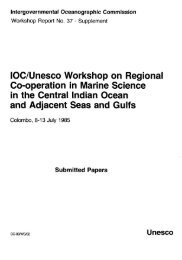Manual on sea level measurement and ... - unesdoc - Unesco
Manual on sea level measurement and ... - unesdoc - Unesco
Manual on sea level measurement and ... - unesdoc - Unesco
- No tags were found...
Create successful ePaper yourself
Turn your PDF publications into a flip-book with our unique Google optimized e-Paper software.
Sea Level Measurement <strong>and</strong> Interpretati<strong>on</strong>Acoustic Gauges without Sounding Tube inside Protective Tube or WellEquipment A ready-to-go package can be purchased from SRD that includes the sensor, the data logger <strong>and</strong> c<strong>on</strong>figurati<strong>on</strong> unit, <strong>and</strong>the communicati<strong>on</strong>s system.Operati<strong>on</strong> The device measures the time of flight of an acoustic pulse from a transducer to the <strong>sea</strong> surface. A bar is fixed at a knowndistance from the transducer, which is used for self-calibrati<strong>on</strong> <strong>and</strong> computati<strong>on</strong> of the velocity of sound before each <strong>measurement</strong>.The time is c<strong>on</strong>verted to a <strong>sea</strong> <strong>level</strong> height using the value of the velocity of sound in air previously computedby means of the fixed bar.Installati<strong>on</strong> This type of acoustic sensor has proved to be accurate enough if placed over an existing well, or inside a protective PVCRequirements tube of 300 mm diameter. The transducer must be located at a minimum distance of around 2–3 metres from the watersurface at any moment. As with many tide gauges, all ancillary equipment (data logger, modem, battery backup), needsto be housed in an adjacent building.Locati<strong>on</strong> Requires a <strong>sea</strong> wall or vertical structure for installati<strong>on</strong>.Calibrati<strong>on</strong> Calibrati<strong>on</strong> of the reference is performed during manufacture, prior to delivery.The calibrati<strong>on</strong> of the velocity of sound is made by means of the reflective bar at a known positi<strong>on</strong> in the acoustic beam.Accuracy 1 cm of <strong>sea</strong> <strong>level</strong>.Cost B<strong>and</strong> 2.Record of Use They have been used successfully in the REDMAR network, the Spanish Harbour Authority’s <strong>sea</strong> <strong>level</strong> network, for nearly16 years. The l<strong>on</strong>g-term means seem to be as accurate or better than the st<strong>and</strong>ard float gauges operating in Spain.CommentsIn areas of large tidal range a l<strong>on</strong>g protective tube is needed which may result in magnified temperature <strong>and</strong>/or temperature-gradienteffects. Very sensitive to the careful design of the installati<strong>on</strong>.Single Transducer Pressure GaugesEquipment Complete ready-to-go package (sub-<strong>sea</strong> pressure sensor, cabling <strong>and</strong> data logger) can be purchased from several manufacturers.Operati<strong>on</strong> Two different opti<strong>on</strong>s are available: (a) an absolute pressure sensor measuring the total pressure due to <strong>sea</strong> <strong>level</strong> <strong>and</strong> atmosphere;(b) a differential sensor which has a vented cable measuring pressure changes due to <strong>sea</strong> <strong>level</strong> al<strong>on</strong>e. C<strong>on</strong>versi<strong>on</strong>of pressure to <strong>sea</strong> <strong>level</strong> height requires knowing <strong>sea</strong>water density. Generally, an average value can be used unless thereare significant <strong>sea</strong>s<strong>on</strong>al or tidal variati<strong>on</strong>s. Pressure sensors are also temperature sensitive, but, since <strong>sea</strong> temperature variesmuch less than atmospheric temperature, this normally has a small effect.Sensors vary in cost by up to a factor of 20. Relatively inexpensive sensors use strain gauge technology. Top-of-the-rangesensors are c<strong>on</strong>structed using quartz crystals. For the latter, the temperature sensitivity of low-pressure sensors is around1 mm/°C. Instrumental drift of the same sensor is about 1 mm per year.Many pressure sensors produce a frequency-modulated output. This can be counted (integrated) by relatively simple electr<strong>on</strong>icsto produce the required <strong>measurement</strong>s. Resoluti<strong>on</strong> therefore depends <strong>on</strong> the integrati<strong>on</strong> period, which is typically15 or 6 minutes, but can be as short as 1 minute <strong>and</strong> still provide sufficient accuracy. Some manufacturers provide equipmentthat does not integrate over the full sampling interval, in order to c<strong>on</strong>serve battery power.Installati<strong>on</strong> These devices can be used virtually anywhere, even <strong>on</strong> shelving beaches. They are normally mounted in an outer protectivetube fastened to a <strong>sea</strong> wall but can be fixed directly <strong>on</strong> the <strong>sea</strong> bed <strong>and</strong> c<strong>on</strong>nected to the shore by armoured cable.RequirementsPressure sensors require very little power <strong>and</strong> can be run for periods of 1–2 years <strong>on</strong> n<strong>on</strong>-rechargeable batteries.Locati<strong>on</strong> Pressure sensors can be used at virtually any site, even in hostile envir<strong>on</strong>ments, such as the polar regi<strong>on</strong>s. Regi<strong>on</strong>s with largevariati<strong>on</strong>s in <strong>sea</strong>water density may cause significant errors.Calibrati<strong>on</strong> Calibrati<strong>on</strong>s traceable to Nati<strong>on</strong>al Physical Laboratory (UK) st<strong>and</strong>ards can be obtained from pressure sensor manufacturers<strong>and</strong> have been shown to remain stable over many years. However, drift in the datum value of a sensor may cause changesto its ‘zero’ value. Re-calibrati<strong>on</strong> at intervals may be necessary. Alternatively, the difficulty of establishing a datum can berectified by using alternative means (e.g. from annual tide pole <strong>measurement</strong>s). These have proved adequate, since thedrift is normally linear with time.(C<strong>on</strong>tinued <strong>on</strong> next page)24IOC <str<strong>on</strong>g>Manual</str<strong>on</strong>g>s <strong>and</strong> Guides No 14 vol IV
















